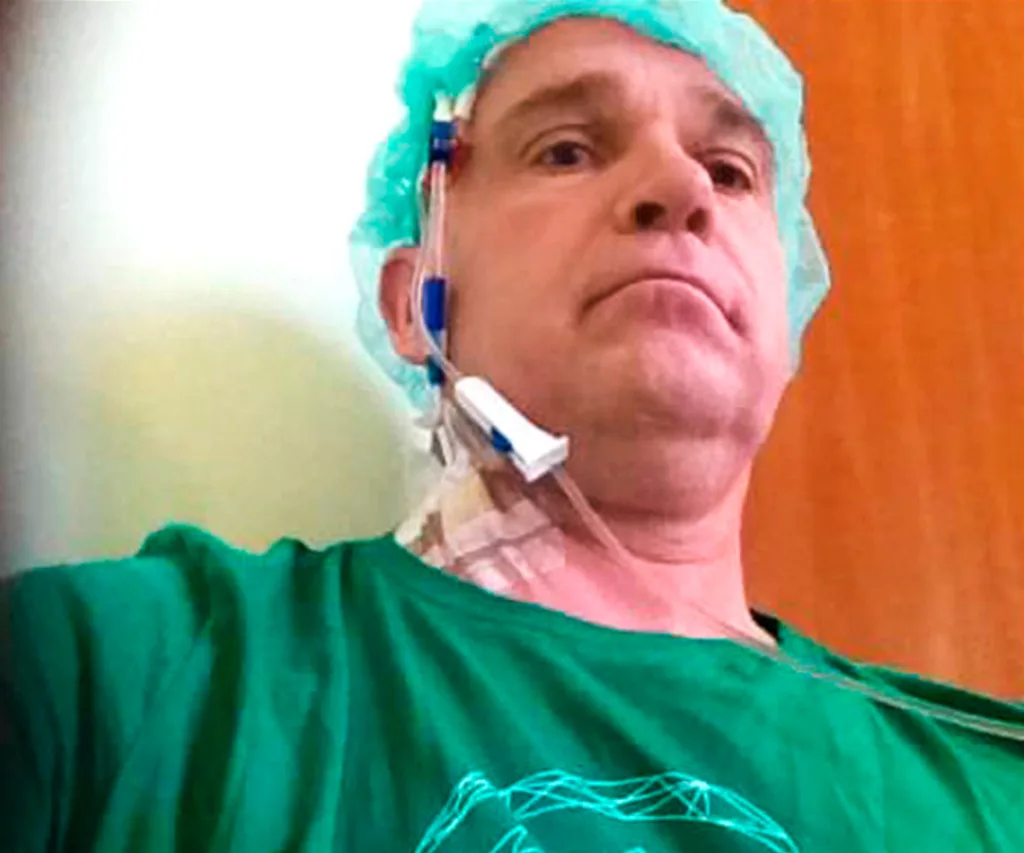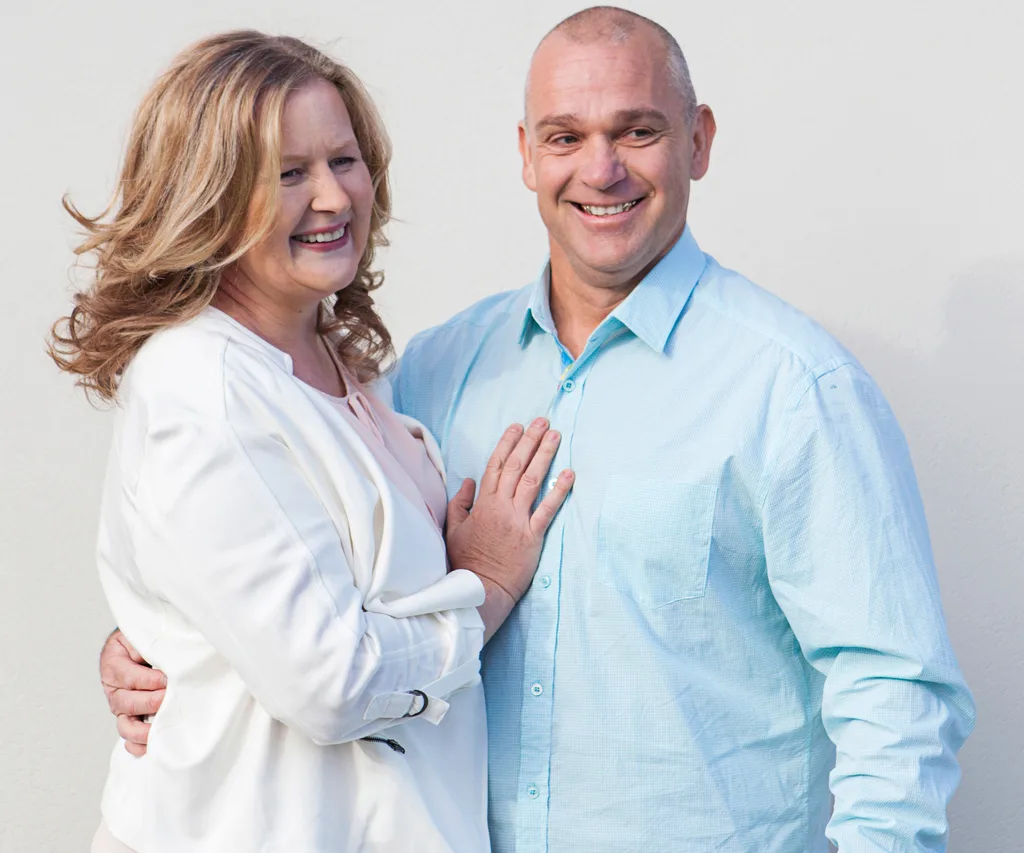The Weekly first spoke to Royce and Gabby Brewer in December 2014 when they were holding out for a medical miracle. More than a year later, kind donors from around the country have helped the couple raise the $76,000 he needed for a new experimental procedure – a stem cell transplant – in an attempt to control the symptoms of multiple sclerosis (MS).
After being diagnosed with MS at just 21 years old, Royce had pretty much given up on planning his future. Three years later, when he met his wife Gabby, he handed her a bunch of pamphlets about the autoimmune disease and told her not to get her hopes up.
“Anytime I tried to talk about anything that was five or 10 years out, he would say, ‘Look, we’re not going to grow old together, so it’s best you get used to it,’ which I chose to ignore,” Gabby recalls.
Now Gabby (44) smiles as she watches her husband open and close his hand with ease – a hand that was crippled just six months ago. For the first time in a long while, Royce (47) can walk without a stick and the headaches that plagued him every day are also gone.
“Every week and month I feel better,” he smiles. “I used to feel dizzy from the time I woke up to the time I went to bed, but that’s totally gone now. I just feel alive, I feel lifted.”
In February, Royce became one of the first New Zealanders to undergo a Hematopoietic Stem Cell Transplantation (HSCT) at a facility in Russia. The procedure is still considered to be in the experimental stage, but clinical trials at facilities around the world have shown remarkable results in patients like Royce.
When the couple first heard about the procedure, it gave them hope. But they faced a two-year waiting list.

“It gave us a chance to raise the money,” Gabby tells. “When Royce said we couldn’t afford it, I told him let’s just apply and worry about the money later.”
The couple will be forever grateful to the Kiwis who donated through crowd-funding website Givealittle and other means to get them there. After raising $76,000, Royce boarded the plane to Moscow in February. Arriving in the dead of winter, he was taken to hospital, where he had a series of tests before being allowed to have the transplant. If he’d failed, he would have been sent home.
“They tested everything – skin, organs, fingernails – your heart and blood vessels have to be able to handle the treatment,” explains Royce. Without enough money
for her flight, Gabby waited anxiously at home. While the procedure sounds gory, Royce says he felt in very capable surgical hands – even though only one doctor spoke English.
His surgeon made an incision in his neck and a long rod was inserted towards his heart, then two million stem cells were extracted from his bone marrow over two days. After that, he had intensive chemotherapy to destroy his immune system, which is responsible for causing the damage due to his MS.
“The procedure sets your clock back to zero so you’re like a brand-new baby,” explains Gabby. “You’re not born with MS, it’s something you get later in life.”

An incision was made in Royce’s neck (above) in preparation for stem cell extraction.
Once Royce’s immune system failed, doctors put the healthy stem cells back into his body so they could renew and multiply. The procedure is not without
its risks – without an immune system, a simple cold could have had devastating consequences.
“I spent about a week in isolation – the doctors would come in wearing masks and gowns,” he recalls. “Then they put me on the plane home, but in business class because there’s less chance of catching a bug.”
Back home, it was another 100 days in isolation for both Royce and Gabby – the time he needed to get about a quarter of his immune system back. It means he could handle a cold but mumps or measles could have terrible effects.
The first sign for Gabby that Royce was improving was his headaches had disappeared and he was sleeping for more than three hours. “He was even snoring,” she laughs.
The couple won’t have scientific proof there has been an improvement until Royce has an MRI scan next month.
With Gabby off work, the couple has sold their large home and are frustrated that Royce, a father-of-three sons, Nick (25), Shaun (23) and Ben (21), had to travel so far away to get the operation. Gabby says it could easily be carried out in New Zealand – and she’s lobbying the government to help thousands of MS sufferers access the treatment.

Gabby and Royce will be forever grateful to the Kiwis who helped fund his treatment.
“We lost Royce’s best friend and Dad to cancer while we were doing this trip, and it’s a real reminder that health is the golden lottery ticket,” she tells.
The couple is now looking to their future, with Royce hoping to retrain so he can get back to work.
In fact, he has even started thinking about the future – with Gabby at his side. “I’ll outlast her now,” he laughs.
The MS Society says:
“Stem cells have generated a lot of excitement because the potential therapeutic benefits are so vast. There is real hope that stem cell transplants may assist in remyelination and could help protect the nervous system from immune attacks.Unfortunately, this interest has also caused untested reports of stem cell transplantation “curing or improving” a wide variety of neurological conditions. The details around many of these claims have rarely been subjected to scientific scrutiny and most, when subjected to such analysis, may have been found wanting. At this stage, the ability for stem cell transplantation to reduce damaged cells within the nervous system is not scientifically confirmed. The majority of therapies are still at an early stage of development and, in most cases, a number of scientific and technical hurdles need to be resolved before clinical application can progress.”
.jpg?resize=720%2C405)
.jpg?resize=380%2C285)

